Ice cream cone
An ice cream cone, poke (Ireland and Scotland) or cornet is a dry, cone-shaped pastry, usually made of a wafer similar in texture to a waffle, which enables ice cream to be held in the hand and eaten without a bowl or spoon. Various types of ice cream cones include wafer (or cake) cones, waffle cones, and sugar cones.
.jpg) A wafer-style ice cream cone with strawberry ice cream. | |
| Type | Pastry |
|---|---|
| Serving temperature | Dry and cold |
| Main ingredients | Flour, sugar |
| Variations | waffle cone, cake or wafer cone, pretzel cone, sugar cone, chocolate-coated cone, double cone, vanilla cone |
| 23 kcal (96 kJ) | |
Many styles of cones are made, including pretzel cones and chocolate-coated cones. A variety of double wafer cone exists that allows two scoops of ice cream to be served side by side. Wafer cones are sometimes made with a flat bottom instead of a pointed, conical shape, enabling the ice cream and "cone" to stand upright on a surface without support. These types of wafer cones are often branded as "cups".
History
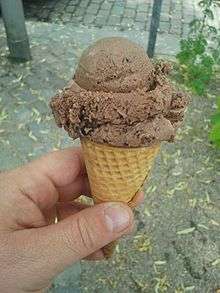
Edible cones were mentioned in French cooking books as early as 1825, when Julien Archambault described how one could roll a cone from "little waffles".[1] Another printed reference to an edible cone is in Mrs A. B. Marshall's Cookery Book, written in 1888 by Agnes B. Marshall (1855–1905) of England. Her recipe for "Cornet with Cream" said that "the cornets were made with almonds and baked in the oven, not pressed between irons".[2][3]
Edible cones were patented by two entrepreneurs, both Italian, separately in the years 1902 and 1903. Antonio Valvona, an ice cream merchant from Manchester, UK, patented a biscuit cup producing machine in 1902, and in 1903, Italo Marchioni, an Italian ice cream salesman, filed for the patent of a machine which made ice cream containers.[2][4]
At the St. Louis World's Fair in 1904, a Syrian/Lebanese concessionaire named Arnold Fornachou was running an ice cream booth. When he ran short on paper cups, he noticed he was next to a waffle vendor by the name of Ernest Hamwi, who sold Fornachou some of his waffles. Fornachou rolled the waffles into cones to hold the ice cream - and this is believed by some (although there is much dispute) to be the moment where ice-cream cones became mainstream.[5]
Abe Doumar and the Doumar family can also claim credit for the ice cream cone.[6] At the age of 16, Doumar began to sell paperweights and other items. One night, he bought a waffle from another vendor transplanted to Norfolk, Virginia from Ghent in Belgium, Leonidas Kestekidès. Doumar proceeded to roll up the waffle and place a scoop of ice cream on top. He then began selling the cones at the St. Louis Exposition. His "cones" were such a success that he designed a four-iron baking machine and had a foundry make it for him. At the Jamestown Exposition in 1907, he and his brothers sold nearly twenty-three thousand cones. After that, Abe bought a semiautomatic 36-iron machine, which produced 20 cones per minute and opened Doumar's Cone's and BBQ In in Norfolk, Virginia, which still operates at the same location over 100 years later.[7][8]
In 2008, the ice cream cone became the official state food of Missouri.[9]
Commercial cones
The earliest cones were rolled by hand, from hot and thin wafers, but in 1912, Frederick Bruckman, an inventor from Portland, Oregon, patented a machine for rolling ice cream cones.
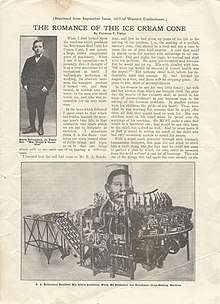
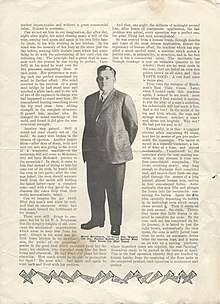
He sold his company to Nabisco in 1928, which is still producing ice cream cones as of 2017. Other ice-cream providers such as Ben & Jerry's make their own cones.
Pre-filled cones
In 1928, J.T. "Stubby" Parker of Fort Worth, Texas created an ice cream cone that could be stored in a grocer's freezer, with the cone and the ice cream frozen together as one item.[10] He formed The Drumstick Company in 1931 to market the product, and in 1991 the company was purchased by Nestlé.
In 1959, Spica, an Italian ice cream manufacturer based in Naples, invented a process whereby the inside of the waffle cone was insulated from the ice cream by a layer of oil, sugar and chocolate. Spica registered the name Cornetto in 1960. Initial sales were poor, but in 1976 Unilever bought out Spica and began a mass-marketing campaign throughout Europe. Cornetto is now one of the most popular ice creams in the world.
In 1979, a patent for a new packaging design by David Weinstein led to easier transportation of commercial ice cream cones. Weinstein's design enabled the ice cream cone to be wrapped in a wax paper package. This made the cones more sanitary while also preventing the paper wrapper from falling off during transportation, or from becoming stuck to the cone.[11]
 A cherry ice cream cone
A cherry ice cream cone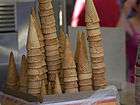 Sugar cones
Sugar cones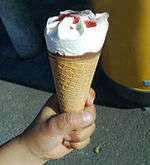 Unwrapped pre-filled cone
Unwrapped pre-filled cone Soft serve ice cream in a wafer style cone
Soft serve ice cream in a wafer style cone A 99 Flake ice cream cone
A 99 Flake ice cream cone Sugar cone dipped in rainbow sprinkles
Sugar cone dipped in rainbow sprinkles- Waffle cones

References
- Julien Archambault, Le Cuisinier économe ou Élémens nouveaux de cuisine, de pâtisserie et d'office, Librairie du commerce, Paris, 1825, page 346.
- Stradley, Linda. "History of Ice Cream Cone". What's Cooking America. Retrieved 2008-05-13.
- Weir, Robert. "An 1807 Ice Cream Cone: Discovery and Evidence". Historic Food. Retrieved 2008-05-13.
- "United States Patent and Trademark Office". Retrieved 5 October 2012.
- Kennedy, Pagan. "Who Made That Ice-Cream Cone?". The New York Times. The New York Times. Retrieved 24 July 2018.
- Marlowe, Jack. "Zalabia and the First Ice-Cream Cone". www.aramcoworld.com (Issue July/August 2003). Aramco Services Company. Retrieved 2016-02-16.
- The Ocean View Nickel Tour - Part VII Archived 2015-02-17 at the Wayback Machine. Rkpuma.com. Retrieved on 2015-11-20.
- History | Doumar's. Doumars.com (2013-06-16). Retrieved on 2015-11-20.
- IT, Missouri Secretary of State -. "The State Dessert - Missouri Secretary of State". sos.mo.gov. Retrieved 2018-01-27.
- Funderburg, Anne Cooper. Chocolate, Strawberry, and Vanilla: A History Of American Ice Cream. Popular Press. Retrieved June 10, 2012.
- "The United States Patent and Trademark Office". Retrieved 11 October 2012.